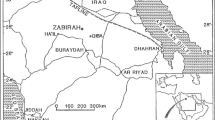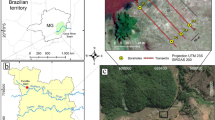Abstract
A ground-penetrating radar (GPR) survey was conducted at the end of August 2009 in the suburb region of Ulaanbaatar, Honhor basin, Mongolia, in combination with conventional methods such as borehole drilling and measurement of ground temperatures. The interface of frozen and unfrozen sediment was distinctly resolved in the interpreted GPR images, verified by the borehole drilling records and 6-month measurement of ground temperatures. The location of the permafrost table was assessed to be at the depth of 2–4 m in the study region. A conspicuous ice-saturated soil layer (massive ground ice) was detected in the interpreted GPR images with a thickness of 2–5 m. The GPR investigation results were consistent with the borehole drilling records and ground temperatures observation. The borehole logs and ground temperatures profile in the borehole indicates that permafrost at Honhor basin is characterized by high ground temperature and high ice content, which implies that ongoing climatic warming would have great influence on permafrost dynamics. The research results are of great importance to further assess permafrost dynamics to climatic change in the boundary of discontinuous and sporadic permafrost regions in Mongolia in the future.









Similar content being viewed by others
References
Arcone SA, Lawson DE, Delaney AJ, Strasser JC, Strasser JD (1998) Ground-penetrating radar reflection profiling of groundwater and bedrock in an area of discontinuous permafrost. Geophysics 63:1573–1584
Arcone SA, Prentice ML, Delaney AJ (2002) Stratigraphic profiling with ground-penetrating radar in permafrost: a review of possible analogs for Mars. J Geophys Res 107(E11):5108. doi:10.1029/2002JE001906
Batima P, Natsagdorj L, Gombluudev P, Erdenetsetseg B (2005) Observed climate change in Mongolia. AIACC workings papers 12: 1–26
Brandt O, Langley L, Kohler J, Hamran S (2007) Detection of buried ice and sediment layers in permafrost using multi-frequency ground penetrating radar: a case examination on Svalbard. Remote Sens Environ 111:212–227
De Pascale GP, Pollard WH, Williams KK (2008) Geophysical mapping of ground ice using a combination of capacitive coupled resistivity and ground-penetrating radar, Northwest Territories, Canada. J Geophys Res 113:15. doi:10.1029/2007JF000585
Doolittle J, Nelson F (2009) Characterising relict cryogenic macrostructures in mid-latitude areas of the USA with three-dimensional ground-penetrating radar. Permafr Periglac Process 20:257–268
Hinkel KM, Doolittle JA, Bockheim JG, Nelson FE, Paetzold R, Kimble JM, Travis R (2001) Detection of subsurface permafrost features with ground-penetrating radar, Barrow, Alaska. Permafr Periglac Process 12:170–190
IPCC (2007) Climate change 2007: the physical science basis. In: Solomon S, Qin D, Manning M, Chen Z, Marquis M and co-authors (eds) Contribution of working group I to the fourth assessment report of the intergovernmental panel on climate change. Cambridge University Press, Cambridge and New York, 996 pp
Ishikawa M, Sharkhuu N, Zhang Y, Kadota T, Ohata T (2005) Ground thermal and moisture conditions at the southern boundary of discontinuous permafrost, Mongolia. Permafr Periglac Process 16:209–216
Jin H, Yu Q, Lv L, Guo D, He R, Yu S, Sun G, Li Y (2007) Degradation of permafrost in the Xing’anling Mountains, Northeastern China. Permafr Periglac Process 18:245–258
Moorman BJ, Robinson SD, Burgess MM (2003) Imaging periglacial conditions with ground-penetrating radar. Permafr Periglac Process 14:319–329
Sandmeier KJ (2010) Reflex 5.5 manual: sandmeier software, Zipser Strabe 1, D-76227 Karlsruhe, Germany
Sharkhuu N (2003) Recent changes in the permafrost of Mongolia. In: Phillips M et al (eds) Proceedings of the 8th international conference on permafrost. A. A. Balkema, Brookfield, pp 1029–1034
Sharkhuu N, Sharkhuu A, Romanovsky VE, Yoshikawa K, Nelson FE, Shiklomanov NI (2008) Thermal state of permafrost in Mongolia. In: Kane DL, Hinkel KM (eds) Proceedings of the 9th international conference on permafrost, Institute of Northern Engineering. University of Alaska, Fairbanks, pp 1633–1638
Sodnom N, Yanshin AL (1990) Geocryology and geocryological zonation of Mongolia. Digitized 2005 by Parsons M.A. Boulder, CO, National Snow and Ice Data Center/World Data Center for Glaciology, Digital Media
Stevens CW, Moorman BJ, Solomon SM, Hugenholtz CH (2009) Mapping subsurface conditions within the near-shore zone of an Arctic delta using ground penetrating radar. Cold Reg Sci Technol 56:30–38
Tumurbaatar B, Mijiddorj B (2006) Permafrost and permafrost thaw in Mongolia. In: Goulden CE et al (eds) The geology, biodiversity and ecology of lake Hovsgol (Mongolia). Backhuys publishers, Leiden, pp 41–48
Wu T, Li S, Cheng G, Nan Z (2005) Using ground-penetrating radar to detect permafrost degradation in the northern limit of permafrost area on the Tibetan Plateau. Cold Reg Sci Technol 41:211–219
Wu T, Wang Q, Watanabe M, Chen J, Battogtokh D (2009) Mapping vertical profile of discontinuous permafrost with ground penetrating radar at Nalaikh depression, Mongolia. Environ Geol 56:1577–1583
Yang M, Wang S, Yao T, Gou X, Lu A, Guo X (2004) Desertification and its relationship with permafrost degradation in Qinghai-Xizang (Tibet) Plateau. Cold Reg Sci Technol 39:47–53
Yoshikawa K, Leuschen C, Ikeda A, Harada K, Gogineni P, Hoekstra P, Hinzman L, Sawada Y, Matsuoka N (2006) Comparison of geophysical investigations for detection of massive ground ice (pingo ice). J Geophys Res, 111(E06S19):10. doi:10.1029/2005JE002573
Zhao L, Wu Q, Marchenko SS, Sharkhuu N (2010) Thermal state of permafrost and active layer in Central Asia during the international polar year. Permafr Periglac Process 21:198–207
Acknowledgments
The study conducted in this paper is funded by the project “Establishment of Early Observation Network for the Impacts of Global Warming”, sponsored by the Ministry of Environment, Japan. This research is also supported by the Global Change Research Program of China (2010CB951402), the National Natural Science Foundation of China (Grant numbers: 40901042) and the Hundred Talents Program of the Chinese Academy of Sciences (51Y251571). The authors also would like to thank all the staff from the Institute of Geography, Mongolian Academy of Sciences for their logistic supports to the fieldwork. Finally, the constructive suggestions from two anonymous reviewers and editor-in-chief are especially appreciated.
Author information
Authors and Affiliations
Corresponding author
Rights and permissions
About this article
Cite this article
Wu, T., Wang, Q., Zhao, L. et al. Investigating internal structure of permafrost using conventional methods and ground-penetrating radar at Honhor basin, Mongolia. Environ Earth Sci 67, 1869–1876 (2012). https://doi.org/10.1007/s12665-012-1629-8
Received:
Accepted:
Published:
Issue Date:
DOI: https://doi.org/10.1007/s12665-012-1629-8




